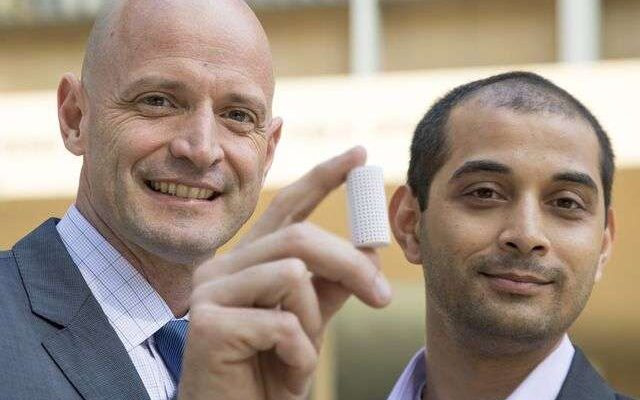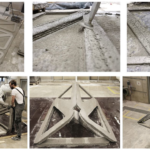

Often, it seems as if concrete is the glue that holds the world together under our busy feet, and wheels–from the smooth driveway you backed out of this morning with that first hot cup of coffee in hand–to the foundation underneath as you traversed the pathway into work. And that’s just a beginning. What about many major road surfaces, dams, large structures, and walls? While we thrive on all the uses for this composite material, when it comes to all the carbon dioxide emissions caused by manufacturing it—there is enormous cause for concern.
Portland cement is a major cause of carbon dioxide emissions, and demand for it grows, worldwide—especially in developing nations. With tons of cement producing tons of carbon dioxide, and plans for the widely used material only expanding, we are offering up major production of greenhouse gases with no true end in sight, it would seem. While most environmentalists and concerned citizens focus on how to stop this, a team of scientists who specialize in both reality and innovation have reversed their thinking. By virtually embracing the very thing that is plaguing us, they are employing research that allows us to use these emissions—which contribute five to seven percent of greenhouse gases—to our benefit.
It’s fascinating to see what can happen when thinking is turned completely around, taking something negative and turning it into a positive. And what a team of interdisciplinary researchers at UCLA are working on is actually nothing short of mind-blowing as they propose not just eliminating greenhouse gases, but also using the carbon dioxide to make new construction materials. While you may have heard the term ‘upcycling’ thrown around here and there, what we are discussing here is no hippie grassroots scene. This team is showing the world the most true–and useful–definition of upcycling.
With a closed-loop process, the UCLA researchers plan to capture carbon from power plants, rather than allowing it to be released into the ozone, and then they will use it to 3D print a new material called, appropriately, CO2NCRETE.
“What this technology does is take something that we have viewed as a nuisance—carbon dioxide that’s emitted from smokestacks—and turn it into something valuable,” said J.R. DeShazo, professor of public policy at the UCLA Luskin School of Public Affairs and director of the UCLA Luskin Center for Innovation.
“It’s complicated. There are many steps in this process.”
And while this may be a new and wonderful concept for you and me, some researchers at UCLA, according to DeShazo, have been working on this concept for their entire careers, over 30 years, looking at how to take a toxic material and make it not only functional, but better and more energy-efficient—and best of all—play a part in tackling climate change. While these emissions have previously been ‘captured,’ up until now, no one was able to shape them—and thanks to 3D printing, these researchers are able to make a viable—and highly beneficial—material.
“We know how to capture the carbon. We know how to improve the efficiency. We know how to shape it with 3D printing, but we need to do all of that at the lab scale now, and begin the process of actually increasing the volume of material and then thinking about how to pilot it commercially,” states DeShazo, who has been responsible for providing ‘public policy and economic guidance’ in terms of this research.
As cement is still being manufactured traditionally—and in enormous amounts—the researchers hope to continue taking the gas and using it to make their new 3D printed material into something that can indeed actually replace cement eventually.

For this project, scientific contributions have been led by Gaurav Sant, associate professor and Henry Samueli Fellow in Civil and Environmental Engineering; Richard Kaner, distinguished professor in chemistry and biochemistry, and materials science and engineering; Laurent Pilon, professor in mechanical and aerospace engineering and bioengineering; and Matthieu Bauchy, assistant professor in civil and environmental engineering.
“The approach we are trying to propose is you look at carbon dioxide as a resource—a resource you can reutilize,” said Gaurav Sant. “While cement production results in carbon dioxide, just as the production of coal or the production of natural gas does, if we can reutilize CO2 to make a building material which would be a new kind of cement, that’s an opportunity.”
“We can demonstrate a process where we take lime and combine it with carbon dioxide to produce a cement-like material,” Sant said. “The big challenge we foresee with this is we’re not just trying to develop a building material. We’re trying to develop a process solution, an integrated technology which goes right from CO2 to a finished product.”
Sant points out that while they have the concept down and are able to 3D print in the lab, with construction, scale is tantamount—and that’s their utmost challenge, in taking their innovation from centimeters in the lab to meters out in the real world. In hoping to make this into a new technology altogether, the powers that be who have an economic stake in such matters would most likely take some convincing, considering this is definitely a deviation from the norm. While the researchers of course would like to apply the benefits of this new concept in the US, they are definitely looking toward China (the largest producer of greenhouse gases) and India, as soon as possible.
“This technology could change the economic incentives associated with these power plants in their operations and turn the smokestack flue gas into a resource that countries can use, to build up their cities, extend their road systems,” DeShazo said. “It takes what was a problem and turns it into a benefit in products and services that are going to be very much needed and valued in places like India and China.”
The history of using concrete is long and varied, throughout the ages, as it was a popular material as far back as 37 BC, used by the master builders of Ancient Rome. While Portland cement has been popular worldwide for the last 200 years or so, uses of concrete and its composition have undergone a variety of transformations over centuries, and this new idea with 3D printed materials certainly represents a huge leap—and what certainly seems to be a very necessary one for the human race.
“I decided to get involved in this project because it could be a game-changer for climate policy,” DeShazo said. “This technology tackles global climate change, which is one of the biggest challenges that society faces now and will face over the next century.”
Do you think this new technology is realistic for the long run, and will truly make a difference in the future? Discuss in the 3D Printed CO2NCRETE forum over at 3DPB.com.
Source: [Phys.Org]
When it comes to 3D real estate visualization in the USA, our service provides the perfect solution for bringing property listings to life. Through our platform, you can easily access cutting-edge 3D renderings that showcase your real estate projects in a way that attracts potential buyers and investors. Whether it's residential, commercial, or mixed-use properties, our team of experts uses advanced technology to create immersive visualizations that highlight the best features of your property, making it easier for clients to imagine the space as their own.
Through our website, you can quickly get high-quality 3D real estate visualizations that are tailored to your specific needs. With our help, you'll stand out in the competitive real estate market by offering potential buyers a realistic, interactive view of your property. Our efficient process ensures a fast turnaround time, while our attention to detail guarantees that every aspect of the property is represented accurately, giving you a powerful marketing tool to promote your real estate listings.






